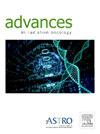How Much Can Optimization of Hypofractionation Help to Reduce Carbon Equivalent Emissions? A Single-Center Modeling Study
IF 2.7
Q3 ONCOLOGY
引用次数: 0
Abstract
Purpose
Climate change poses a major threat to public health. The health care sector paradoxically contributes significantly to greenhouse gas emissions. In radiation therapy, increased hypofractionation could reduce both patient transport and linear accelerator (LINAC) use, but the size of the impact remains largely undocumented. We estimated department-wide CO2 equivalent (CO2e) emissions of patient transport and LINAC energy consumption both in a real-world scenario and in a hypothetical maximized hypofractionation scenario.
Methods and Materials
We performed a retrospective exploratory study of all patients treated with external beam radiation therapy in 2019 (pre-COVID-19 year) at the University Hospitals Leuven (Belgium). CO2e emissions of patient transport were modeled by considering the kilometers traveled by car between the patient’s home and the hospital as well as the number of visits necessary for the treatment. Second, the hypothetical impact of implementing the most hypofractionated schedules according to the current (December 2024) best scientific evidence was calculated using the model. Finally, energy consumption of our Varian TrueBeam and Halcyon LINAC was measured to calculate the related CO2e emissions.
Results
In 2019, there were 43,433 patient visits over 2625 external beam radiation therapy courses with an estimated total of 2.67 million km traveled, resulting in an estimated 394 t of CO2e emissions. Implementation of hypothetical maximalized hypofractionation would decrease emissions by 18.3% (95% CI, 17.7%-20.0%) on average. The reduction was much larger for early breast cancer (–32.4%) and prostate cancer (–48.5%) than for all the other pathologies (–7.0%). Comparing a prostate treatment in 16 (n = 2 patients) and 5 (n = 2) fractions on the TrueBeam and 16 (n = 2) fractions on the Halcyon, energy use was, respectively, 47.1, 23.6, and 9.2 kWh over the total course, or 6.17, 3.10, and 1.21 kg of CO2e emissions.
Conclusions
In our hypothetical scenario, maximal optimization of hypofractionation schedules significantly reduces CO2e emissions by decreasing patient transport and, to a much lesser extent, energy consumption.
减分馏优化能在多大程度上减少碳当量排放?单中心模型研究
气候变化对公众健康构成重大威胁。自相矛盾的是,卫生保健部门对温室气体排放的贡献很大。在放射治疗中,增强的低分割可能会减少患者转运和直线加速器(LINAC)的使用,但影响的大小在很大程度上仍未得到证实。我们估计了在真实情景和假设的最大低分馏情景下,全部门患者运输的二氧化碳当量(CO2e)排放量和LINAC能源消耗。方法和材料我们对2019年(covid -19前一年)在比利时鲁汶大学医院接受外束放射治疗的所有患者进行了回顾性探索性研究。通过考虑患者家和医院之间的汽车行驶公里以及治疗所需的就诊次数,对患者运输的二氧化碳排放量进行了建模。其次,使用该模型计算了根据当前(2024年12月)最佳科学证据实施最低分割时间表的假设影响。最后,我们测量了瓦里安TrueBeam和Halcyon LINAC的能耗,以计算相关的二氧化碳排放量。结果2019年,在2625个外部束放射治疗疗程中,有43,433名患者就诊,估计总行程为267万公里,导致估计394 t二氧化碳排放量。实施假设的最大化低分馏将使排放量平均减少18.3% (95% CI, 17.7%-20.0%)。早期乳腺癌(-32.4%)和前列腺癌(-48.5%)的降幅远远大于所有其他病理(-7.0%)。比较TrueBeam上16 (n = 2)组和5 (n = 2)组的前列腺治疗,以及Halcyon上16 (n = 2)组的前列腺治疗,在整个过程中,能源消耗分别为47.1、23.6和9.2千瓦时,或6.17、3.10和1.21千克的二氧化碳排放量。在我们的假设情景中,最大限度地优化低分馏时间表可以通过减少患者运输和在更小程度上减少能源消耗来显著减少二氧化碳排放。
本文章由计算机程序翻译,如有差异,请以英文原文为准。
求助全文
约1分钟内获得全文
求助全文
来源期刊

Advances in Radiation Oncology
Medicine-Radiology, Nuclear Medicine and Imaging
CiteScore
4.60
自引率
4.30%
发文量
208
审稿时长
98 days
期刊介绍:
The purpose of Advances is to provide information for clinicians who use radiation therapy by publishing: Clinical trial reports and reanalyses. Basic science original reports. Manuscripts examining health services research, comparative and cost effectiveness research, and systematic reviews. Case reports documenting unusual problems and solutions. High quality multi and single institutional series, as well as other novel retrospective hypothesis generating series. Timely critical reviews on important topics in radiation oncology, such as side effects. Articles reporting the natural history of disease and patterns of failure, particularly as they relate to treatment volume delineation. Articles on safety and quality in radiation therapy. Essays on clinical experience. Articles on practice transformation in radiation oncology, in particular: Aspects of health policy that may impact the future practice of radiation oncology. How information technology, such as data analytics and systems innovations, will change radiation oncology practice. Articles on imaging as they relate to radiation therapy treatment.
 求助内容:
求助内容: 应助结果提醒方式:
应助结果提醒方式:


